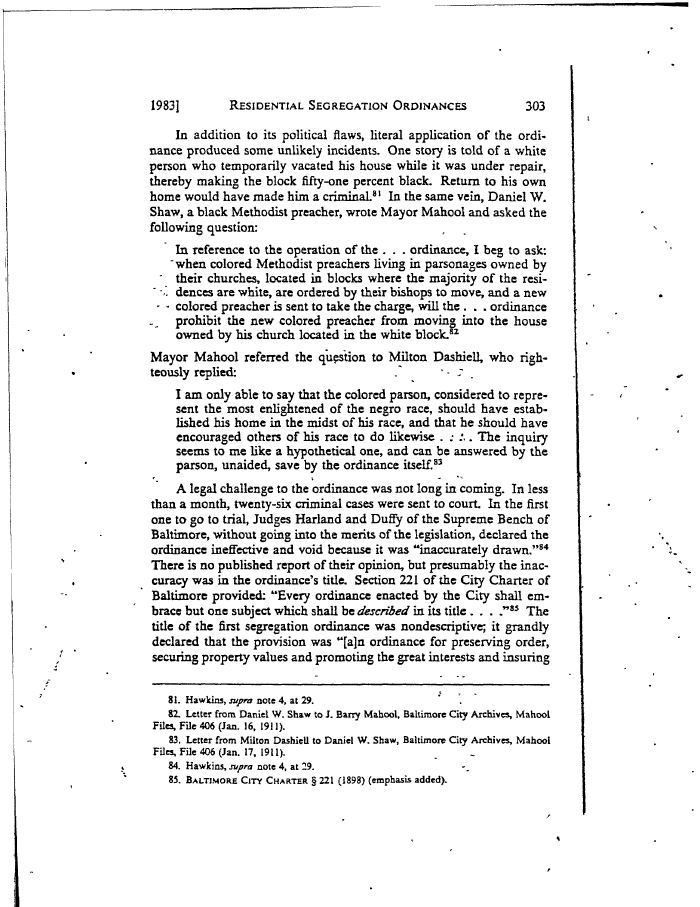 |
||||
|
Garrett Power, Apartheid Baltimore Style: The Residential Segregation Ordinances of 1910-1913, Maryland Law Review, 42 (1983) , Image No: 16 Enlarge and print image (60K) << PREVIOUS NEXT >> |
 |
||||
|
Garrett Power, Apartheid Baltimore Style: The Residential Segregation Ordinances of 1910-1913, Maryland Law Review, 42 (1983) , Image No: 16 Enlarge and print image (60K) << PREVIOUS NEXT >> |
| 1983] RESIDENTIAL SEGREGATION ORDINANCES 303 In addition to its political flaws, literal application of the ordi- nance produced some unlikely incidents. One story is told of a white person who temporarily vacated his house while it was under repair, thereby making the block fifty-one percent black. Return to his own home would have made him a criminal.81 In the same vein, Daniel W. Shaw, a black Methodist preacher, wrote Mayor Mahool and asked the following question: In reference to the operation of the . . . ordinance, I beg to ask: when colored Methodist preachers living in parsonages owned by their churches, located in blocks where the majority of the residences are white, are ordered by their bishops to move, and a new colored preacher is sent to take the charge, will the . . . ordinance prohibit the new colored preacher from moving into the house owned by his church located in the white block.82 Mayor Mahool referred the question to Milton Dashiell, who righ- teously replied: I am only able to say that the colored parson, considered to repre- sent the most enlightened of the negro race, should have estab- lished his home in the midst of his race, and that he should have encouraged others of his race to do likewise. The inquiry seems to me like a hypothetical one, and can be answered by the parson, unaided, save by the ordinance itself.93 A legal challenge to the ordinance was not long in coming. In less than a month, twenty-six criminal cases were sent to court In the first one to go to trial, Judges Harland and Duffy of the Supreme Bench of Baltimore, without going into the merits of the legislation, declared the ordinance ineffective and void because it was "inaccurately drawn.84 There is no published report of their opinion, but presumably the inac- curacy was in the ordinance's title. Section 221 of the City Charter of Baltimore provided: "Every ordinance enacted by the City shall em- brace but one subject which shall be described in its title . . . ,"85 The title of the first segregation ordinance was nondescriptive; it grandly declared that the provision was "[a]n ordinance for preserving order, securing property values and promoting the great interests and insuring 81. Hawkins, supra note 4, at 29. 82. Letter from Daniel W. Shaw to J. Barry Mahool, Baltimore City Archives, Mahool Files, File 406 (Jan. 16, 1911). 83. Letter from Milton Dashiell to Daniel W. Shaw, Baltimore City Archives, Mahool Files, File 406 (Jan. 17, 1911). 84. Hawkins, supra note 4, at 29. 85. BALTIMORE CITY CHARTER § 221 (1898) (emphasis added). |